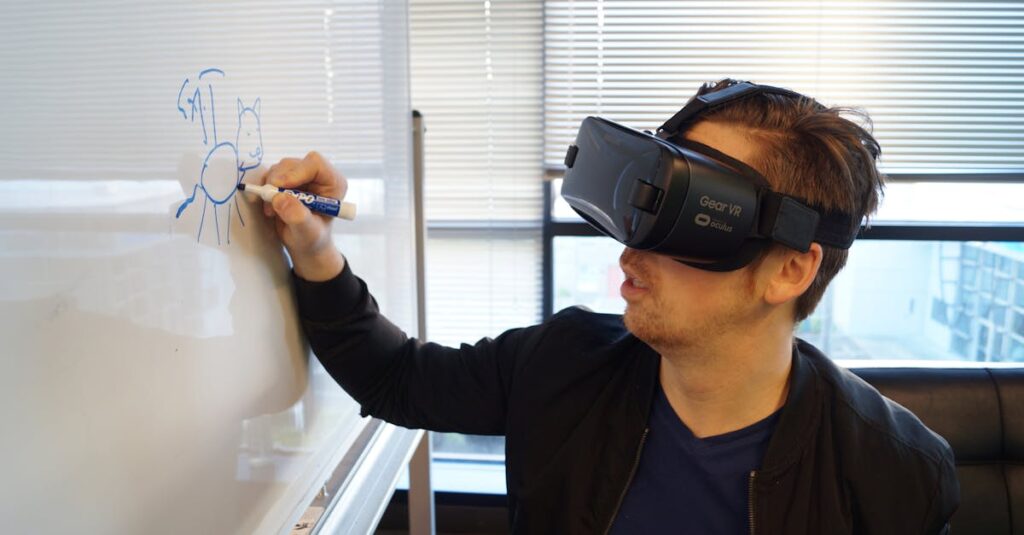Introduction
Have you ever wondered what it would be like to step into a history book? Or walk through the human bloodstream in a science class? With virtual reality (VR), this is no longer just a dream. It’s becoming a real possibility in classrooms across the globe. But is VR the future of education, or is it just a passing trend? Let’s explore how this technology is changing the way we learn,and whether it’s here to stay.
The Rise of Virtual Reality in Education
Virtual reality has made a splash in various industries, from gaming to healthcare, but its application in education is particularly exciting. Imagine sitting in a classroom and, instead of reading about the pyramids, actually walking around inside one. Or maybe you’re not just learning about marine biology but swimming alongside a school of fish in the ocean. This immersive learning experience could make complex subjects easier to understand and more engaging for students.
In recent years, schools, universities, and training centers have begun experimenting with VR. Take the example of Stanford University’s immersive learning environments, which have allowed students to interact with 3D models of ancient civilizations, distant planets, or even different ecosystems. Such hands-on experiences have shown to boost comprehension and retention by engaging students in a multi-sensory way.
How Virtual Reality is Changing the Classroom
While some schools are still trying to figure out how to incorporate VR into their curriculum, there are already impressive examples of how it’s transforming education. Here are just a few ways that VR is making a difference:
- Enhanced Engagement: Let’s face it—students sometimes struggle with traditional textbooks. But when they can interact with a subject in a 3D environment, their interest skyrockets. VR allows students to explore new worlds, manipulate objects, and experience things they otherwise couldn’t. Imagine learning about the solar system, and instead of reading about planets, you’re actually flying through space, observing planets up close. How cool is that?
- Accessibility: Not all students can visit distant historical sites or natural wonders. VR can bring these experiences to their fingertips, making education more inclusive. Virtual field trips to the Louvre, Great Wall of China, or the Amazon rainforest are just a few examples of how VR breaks down geographic barriers.
- Real-World Skills: In fields like medicine, engineering, or even the arts, VR can simulate real-life situations that might be too dangerous or costly to recreate in real life. For example, medical students can practice surgeries in a virtual environment before ever touching a scalpel. VR can also provide safe spaces for students to practice soft skills like negotiation or teamwork in simulated environments.
Challenges to Widespread Adoption
While VR in education sounds revolutionary, there are still some hurdles to overcome before it becomes mainstream. The most obvious challenge is cost. High-quality VR headsets and equipment are still expensive, which makes it difficult for schools with tight budgets to implement the technology.
Another concern is that VR, while engaging, can be overwhelming for some students. Some might experience motion sickness or discomfort, especially during longer sessions. And while VR does provide immersive experiences, there is a risk that it could isolate students from the social aspects of traditional learning. If students spend too much time in virtual worlds, they may miss out on developing crucial social skills.
Then there’s the matter of training teachers. Educators need to be properly trained on how to use VR effectively in the classroom. Without the right guidance, the technology could quickly turn into a gimmick rather than an educational tool.
Is VR the Future of Education? A Balanced Perspective
So, is VR the future of education? It’s hard to say with certainty, but the potential is certainly there. Virtual reality can bring education to life, offering experiences that textbooks and traditional teaching methods simply can’t provide. It can make learning more engaging, accessible, and interactive. However, it’s not without its challenges. The high costs, possible side effects, and need for proper teacher training are real obstacles that need to be addressed.
In the end, VR may not replace traditional education entirely, but it could complement it in ways we never imagined. For instance, a history lesson might involve both reading about the past and experiencing it through VR, providing students with a more well-rounded understanding. The key will be integrating VR in a way that enhances education without overwhelming students or teachers.
What Can We Expect in the Future?
If VR continues to evolve, we might see a day when every classroom is equipped with VR headsets. Schools might adopt VR-based curriculums that allow students to learn in environments tailored to their specific needs. Students with learning disabilities, for example, could benefit from VR’s ability to create customized, interactive lessons that cater to their individual strengths and challenges.
As technology improves and becomes more affordable, we could see VR becoming a staple in education. In fact, some experts predict that VR in education will be as commonplace as laptops and tablets in the next decade. If that’s true, the classrooms of tomorrow could look very different from what we know today.
Conclusion
Virtual reality in education holds immense potential, from bringing history to life to enabling hands-on learning in fields that require specialized skills. It’s an exciting time for educators and students alike. However, it’s important to approach this technology with a balanced perspective. While VR can enhance education, it’s not a magic bullet. Like any tool, its success depends on how well it is integrated into the learning process.
If you’re a student, teacher, or parent, consider how VR could change your own educational journey. Whether it’s exploring new places, mastering a new skill, or simply making learning more fun, the future could be just a headset away. The question is: are we ready to embrace it?

